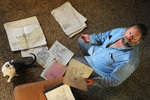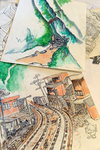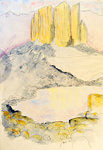


Hank Claycamp sprawls out on the living room floor of his Centralia home. Dozens of his drawings and paintings of ink and watercolor surround him.
The 60-year-old picks up one of the paintings at random. This one depicts a village at sunset near the ancient Incan city of Machu Picchu. Houses with rooftops of every color of the rainbow are shadowed beneath the majestic Andes Mountains towering in the distance.
Claycamp is a globe-trotter. Since high school, he estimates he’s been to more than 25 countries. But he doesn’t have many photographs from trips, and even fewer souvenirs. Instead of bringing back knick-knacks, Claycamp always brings back armful of sketches and paintings he’s created himself, inspired from his travels.
“It’s always amazing the people you meet when you travel, and a lot of them are so appreciative,” Claycamp told The Chronicle last month, shortly before he left on another long trip. “They think, ‘Somebody’s taking the time to make a picture of us,’ and it opens up so many doors.”
Each handmade sentiment has a story behind it. The Machu Picchu painting seems to speak of a calm and serene experience, but Claycamp tells a much bloodier tale. He and his wife, Linda, were hiking up some steep terrain on an ancient Incan trail when a sharp rock came tumbling down and cut a deep gash in Linda’s leg, exposing the bone. They were a couple thousand feet up, and they had to hike for several hours before they got back to an area accessible for a vehicle to take her back to town. She survived. While Linda healed, Claycamp made the painting of the village he saw.
Not all of his paintings evoke memories of gore. There’s one of Clyde, a camel he watched while having a drink with a friend in Mongolia. There’s a landscape from an impromptu trip to Olympia, Greece, where he and Linda once stayed, hunkered down at a hostel in the middle of winter with not much else but some shorts and a couple T-shirts.
“My wife and I both looked at each other and said, ‘This must be a nice place to visit ... during the summer,’” he said with a laugh.
Claycamp’s life has always been “vagabond-ish.” He admits he always had an urge to travel at a young age. He also said he enjoyed sketching and drawing things as a child, but “wasn’t very good at it” because he “thought everyone did it.”
It wasn’t until after he began traveling around the world when he combined the two interests.
Globe-Trotting
As a teenager and young adult, Claycamp worked odd jobs. In the summer he bailed hay, and when he got older, he worked for a plastering company. Soon after graduation, he decided on a whim to go to Las Vegas. His mode of travel: stowing away in a railroad boxcar.
To make money, he would do yard work and other odd jobs in exchange for food or a place to spend the night. Sometimes he would camp out in the middle of nowhere, eating “mulligan stew,” which was a mix of squirrels, rats and whatever other wild field animals he could get hold of.
Most people might squirm at the thought of eating vermin for dinner, but to Claycamp, a less-than-first-class menu paled in comparison to traveling cross-country for free.
“It was great fun,” Claycamp said. “Excellent.”
He returned to Chehalis for a few months to do some more odd jobs. But as soon as he scraped up enough money, he went to Europe to visit some relatives in Denmark and to tour Germany, Switzerland and Holland. After a year he came back to the United States. And that’s the way Claycamp lived most of his adult life: working for a while and then traveling whenever he got the chance.
During the times he was in Europe, he wanted to learn how to blow glass. When he got back to the Pacific Northwest, he apprenticed for an artist in Seattle. While he apprenticed, he renovated apartment buildings.
Glass-blowing would be a skill he would profit from in the 1980s. When Mount St. Helens erupted in 1980, Claycamp saw it as a business venture. He returned to the Twin Cities and operated a shop where he created and sold hand-blown glass items made from the volcanic ash.
His artwork was well-received. He has a letter from Nancy Reagan’s staff at the White House thanking him for some volcanic ash Christmas ornaments he sent. He said a few of the ornaments wound up on display at the Smithsonian American Art Museum.
“I kind of waited for Mount St. Helens to blow up,” he said. “I knew somehow I was going to benefit from it.”
During this time, he met and married Linda Claycamp, who is now a retired Lewis County postal employee.
New Ventures
In 1998 Hank decided to sell his business on South Tower Avenue, though the outfit continued to lease his space until 2001, when the new owners moved to Toledo.
Claycamp still does some glasswork himself, though he doesn’t deal with volcanic ash much anymore. He has a special glass-blowing furnace behind his house. He spends some time in the Twin Cities making and selling his creations. His goal isn’t to sell as many goods as he can, just enough to fuel his and his wife’s traveling habit.
They don’t do a lot of debating on which country to explore next. If they see a place in a magazine or on television that seems interesting, they’ll go.
Linda has the attitude of a college-aged backpacker who wants to explore the world for the first time and becomes giddy when talking about her next destination, she admitted in a 2007 Chronicle profile.
“I like traveling and speaking in Spanish and talking to others so they understand you,” she said. “I like to see how people live; their culture; their food.”
Earlier this month the Claycamps left the Twin Cities to go to Spain, where Linda has been teaching English to some students as part of an exchange program for a few months. They plan to spend Christmas in Cairo, Egypt. After her work is done, they’re planning on visiting Berlin, Moscow and one of Hank’s children, who married a woman in Mongolia. Hank said they may spend some time in the Canary Islands. There’s no firm date for them to return, though he estimates it’ll be sometime in 2012.
And after that?
“Who knows?” Hank said. “When we got married, we made a pact that we’ve got to do this while we’re alive. There’s always going to be another hill and you’ve got to see what’s on the other side.”
•••
Rachel Thomson: (360) 807-8245